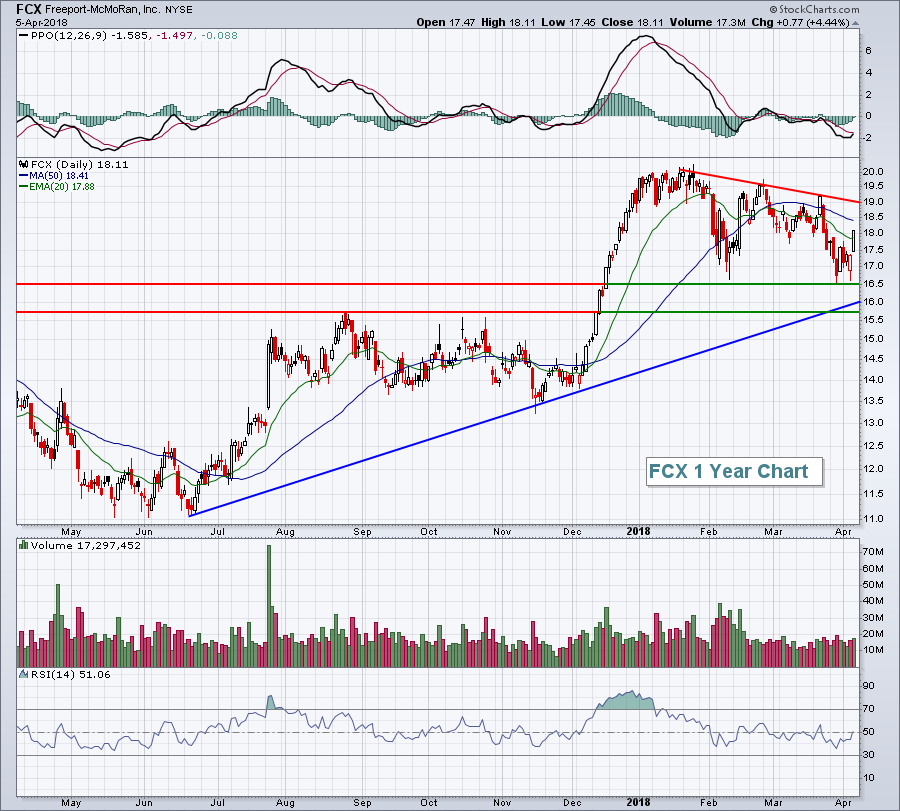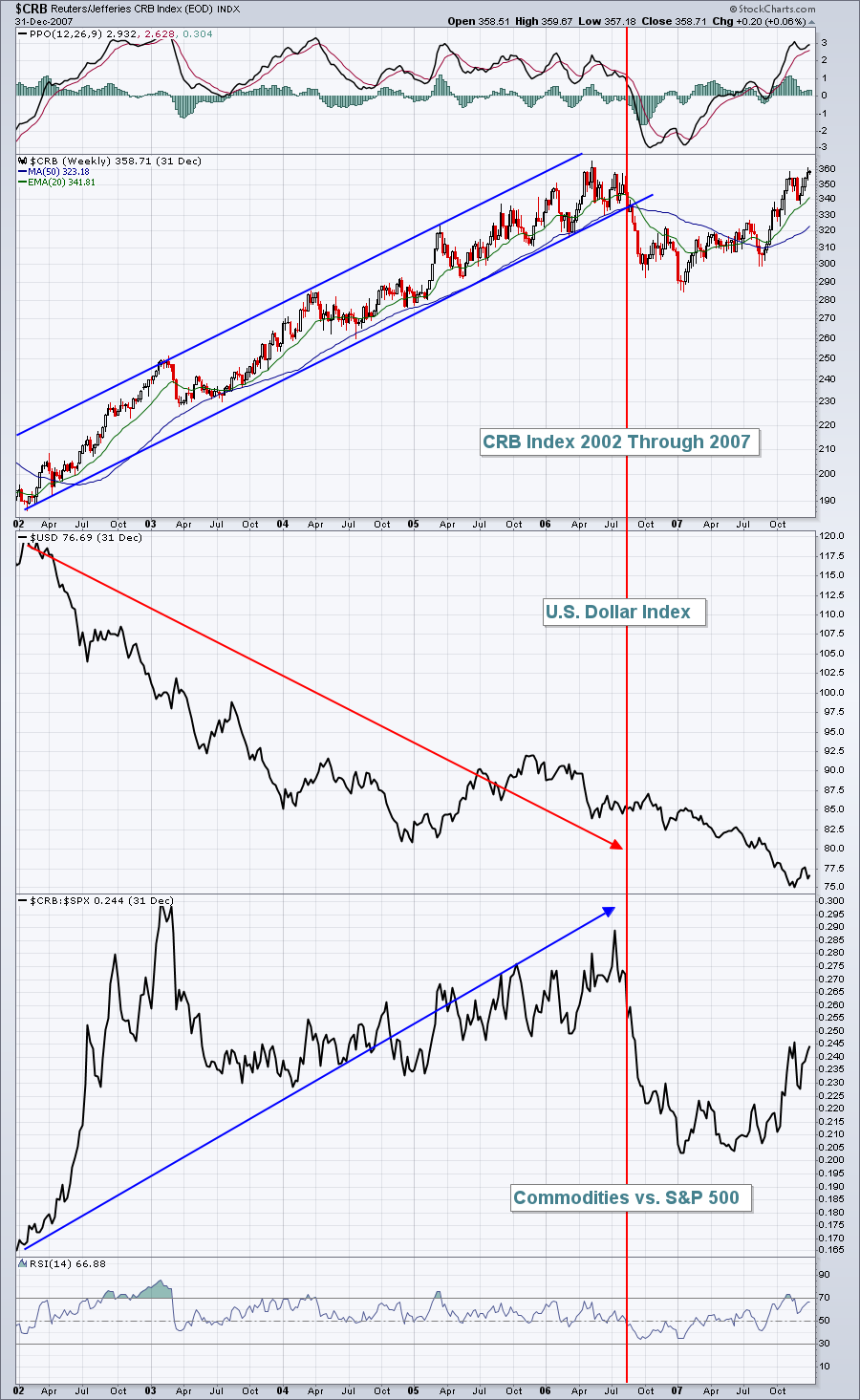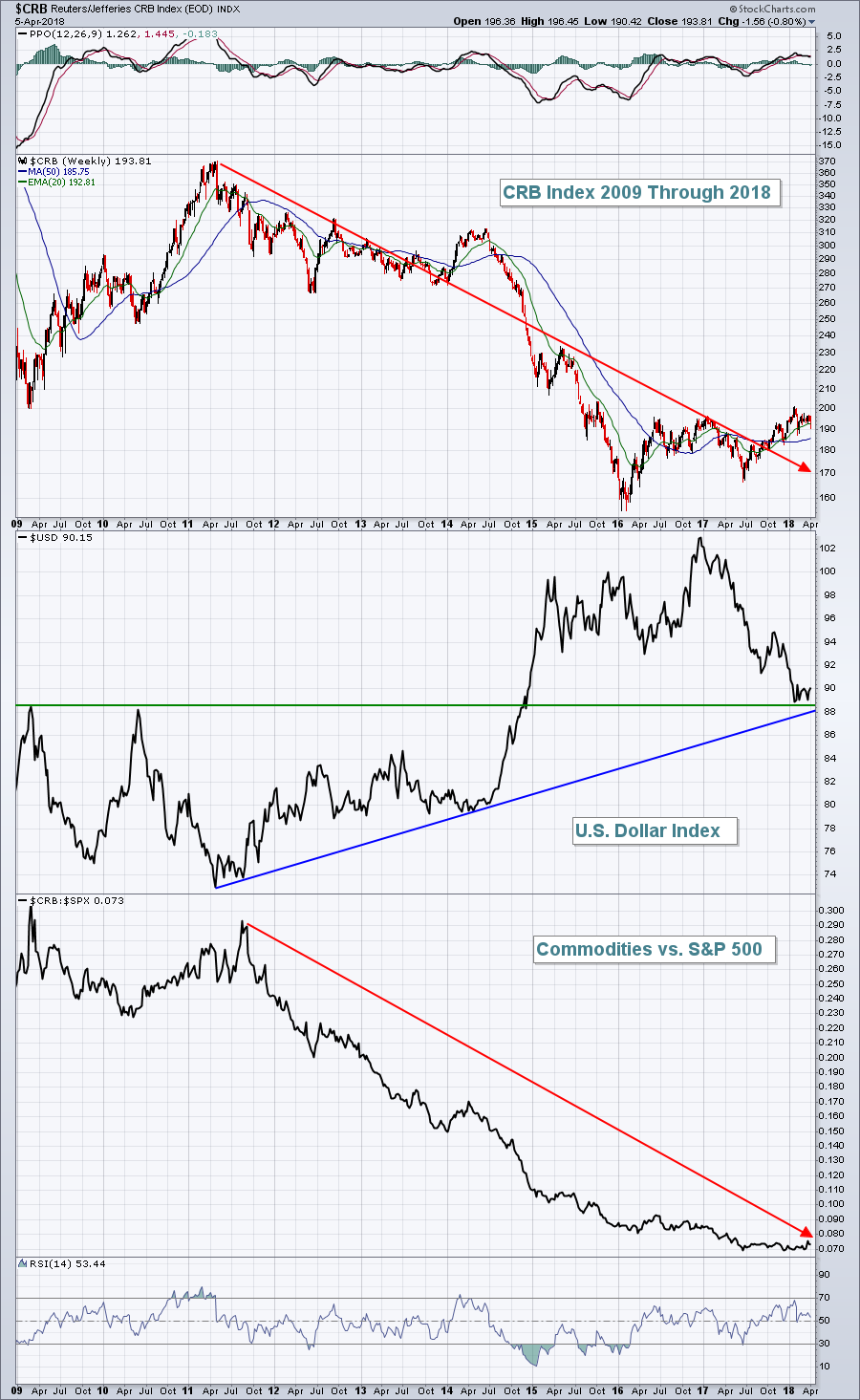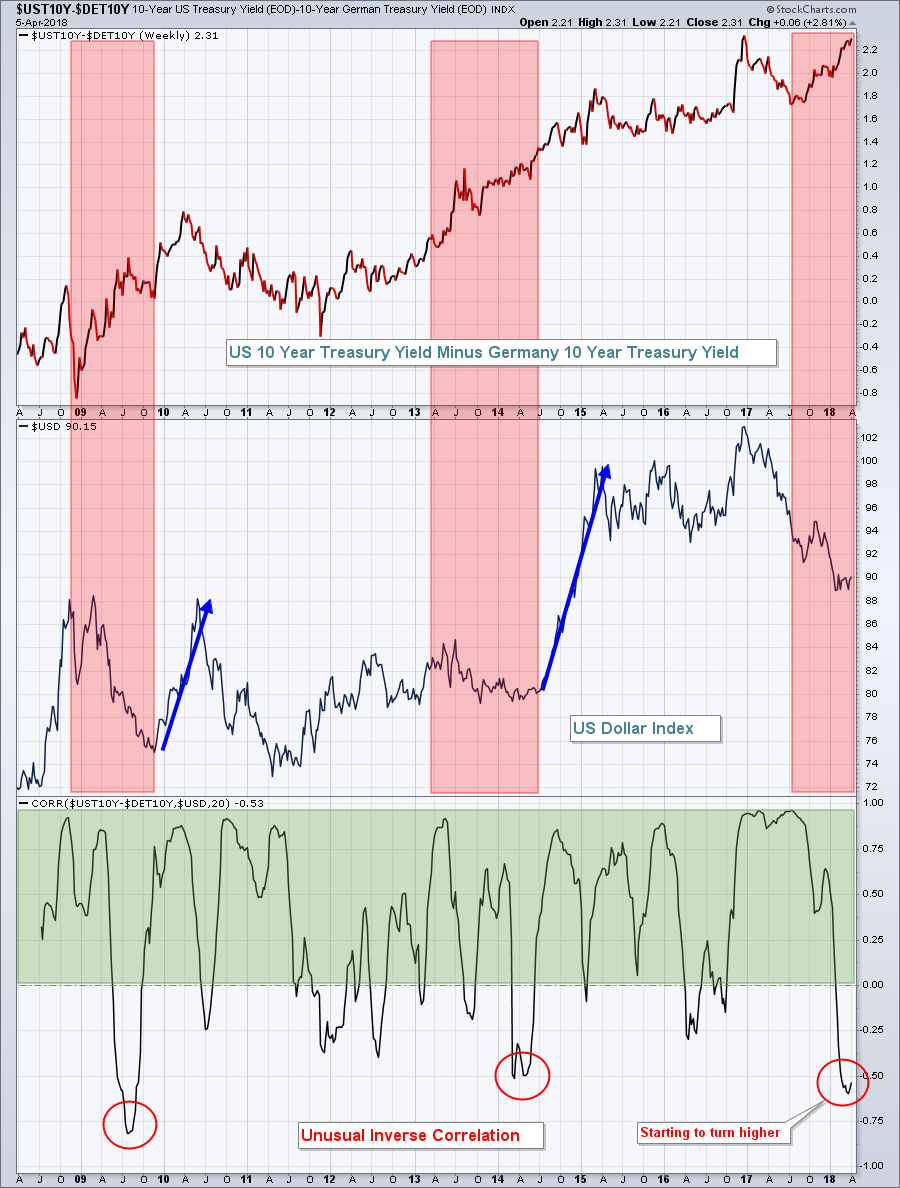Market Recap for Thursday, April 5, 2018
The latest recovery attempt continued into Thursday of this week, but weak futures this morning will provide yet one more obstacle for the bulls to overcome. I'll talk more about that in the Pre-Market Action section below.
In the meantime, eight of nine sectors advanced Thursday with healthcare (XLV, -0.07%) the only sector to defect. Biotechnology stocks ($DJUSBT) were the primary culprit of weakness in healthcare as this aggressive industry group fell 1.21% on the session. It disguised strength in other parts of healthcare like medical equipment ($DJUSAM, +0.84%) and medical supplies ($DJUSMS, +0.69%).
Technology (XLK, +0.41%) was a relative laggard as semiconductors ($DJUSSC) were one of two technology industry groups to lose more than 1%. I highlighted the DJUSSC in my Wednesday blog article, "A Volatility War Has Been Declared" and suggested we could see additional technical selling near-term as we had not yet reached any key price support level. The DJUSSC chart can be viewed under the Sector/Industry Watch section of that blog article.
Turning to strength, materials (XLB, +1.86%) and energy (XLE, +1.80%) were the top two sectors. Freeport McMoran (FCX) rebounded off price support to lead a strong nonferrous metals group ($DJUSNF, +4.44%). FCX remains in a bullish uptrend, although Thursday's strength did not signal any type of a breakout:
 The key support ranges from 15.75-16.50, while bulls should look for a trendline break above 19.00 with increasing volume as a bullish confirmation signal.
The key support ranges from 15.75-16.50, while bulls should look for a trendline break above 19.00 with increasing volume as a bullish confirmation signal.
Pre-Market Action
Stock futures are under pressure once again as a potential trade war heats up. President Trump proposed $100 billion in additional tariffs against China and China's Ministry of Commerce has promised retaliation. That has resulted in what appears will be another weak open for U.S. equities. It hasn't helped that March nonfarm payrolls came up well short of expectations (103,000 vs. 175,000) just two days after the March ADP employment report produced a strengthening jobs environment.
Dow Jones futures are lower by 213 points with a bit more than 30 minutes left to today's opening bell.
Current Outlook
Commodities, as a group, have not performed well during the current 9 year bull market. The reason? A strengthening dollar ($USD) since 2011. During the bull market that ran from 2002 through 2007, the USD was falling and that enabled the CRB index ($CRB) to outperform the benchmark S&P 500. Check it out:
 During that earlier bull market, the USD was clearly under pressure and that resulted in a commodity space that outperformed the S&P 500 thoroughly (except for relative weakness in the first half of 2003). The direction of the dollar plays a major role in commodity performance. It's the reason why I've been avoiding most commodities and commodity stocks during the current bull market. Take a look at the differing view of the USD now vs. what we witnessed from 2002 to 2007:
During that earlier bull market, the USD was clearly under pressure and that resulted in a commodity space that outperformed the S&P 500 thoroughly (except for relative weakness in the first half of 2003). The direction of the dollar plays a major role in commodity performance. It's the reason why I've been avoiding most commodities and commodity stocks during the current bull market. Take a look at the differing view of the USD now vs. what we witnessed from 2002 to 2007:
 See the difference? This bull market has featured a mostly rising dollar and that's bad for commodities. The relative performance of the CRB has been awful and, at this point, I see no reason to expect anything different. The direction of the 10 year treasury yield ($UST10Y) vs. the German 10 year treasury yield ($DET10Y) suggests an upcoming rally in the dollar, possibly a huge rally. Accordingly, I would avoid commodities altogether. They certainly could go higher, but with a rising dollar, I suspect they'll continue to underperform the benchmark S&P 500. In the Sector/Industy Watch section below, I've reprinted a chart that I provided five weeks back showing the relationship between U.S. treasury yields vs. German treasury yields and what that typically means for the USD.
See the difference? This bull market has featured a mostly rising dollar and that's bad for commodities. The relative performance of the CRB has been awful and, at this point, I see no reason to expect anything different. The direction of the 10 year treasury yield ($UST10Y) vs. the German 10 year treasury yield ($DET10Y) suggests an upcoming rally in the dollar, possibly a huge rally. Accordingly, I would avoid commodities altogether. They certainly could go higher, but with a rising dollar, I suspect they'll continue to underperform the benchmark S&P 500. In the Sector/Industy Watch section below, I've reprinted a chart that I provided five weeks back showing the relationship between U.S. treasury yields vs. German treasury yields and what that typically means for the USD.
Sector/Industry Watch
They say a picture paints a thousand words. I say a picture (a chart) can save you thousands of dollars. U.S. treasury yields are in an undisputed uptrend vs. German treasury yields ($UST10Y minus $DET10Y) and the USD has a very strong positive correlation with this treasury yield relationship:
 The reason that U.S. treasury yields would rise faster is that the markets believe our economy is stronger or expected to strengthen quicker. A strengthening dollar would be expected during a period of economic strength. The bottom of the chart above highlights the typical positive correlation that supports my argument. However, there have been short-lived periods where we've seen an inverse relationship develop (red circles). Once the inverse relationship has peaked, though, we've seen huge subsequent rallies in the USD. That, in a nutshell, is why I'd be very cautious in owning commodities. The setup of the dollar, in my view, is extremely bullish and that spells trouble for the CRB Index. If you own or want to own commodities, you want to see the USD lose support near 88. Until that happens, I'd expect commodities to underperform the S&P 500. Since my goal is to try to outperform that benchmark index, I am avoiding commodities and commodity-related stocks.
The reason that U.S. treasury yields would rise faster is that the markets believe our economy is stronger or expected to strengthen quicker. A strengthening dollar would be expected during a period of economic strength. The bottom of the chart above highlights the typical positive correlation that supports my argument. However, there have been short-lived periods where we've seen an inverse relationship develop (red circles). Once the inverse relationship has peaked, though, we've seen huge subsequent rallies in the USD. That, in a nutshell, is why I'd be very cautious in owning commodities. The setup of the dollar, in my view, is extremely bullish and that spells trouble for the CRB Index. If you own or want to own commodities, you want to see the USD lose support near 88. Until that happens, I'd expect commodities to underperform the S&P 500. Since my goal is to try to outperform that benchmark index, I am avoiding commodities and commodity-related stocks.
Historical Tendencies
Over its 9 years trading as a public company, Tesla's (TSLA) best three month performance stretch has clearly been during April, May and June, where it's produced average monthly returns of +10.4%, +13.1% and +9.5%, respectively. Despite much negative publicity recently, TSLA has already gained approximately 15% in just the first four trading days of April.
Key Earnings Reports
None
Key Economic Reports
March nonfarm payrolls released at 8:30am EST: 103,000 (actual) vs. 175,000 (estimate)
March private payrolls released at 8:30am EST: 102,000 (actual) vs. 175,000 (estimate)
March unemployment rate released at 8:30am EST: 4.1% (actual) vs. 4.0% (estimate)
March average hourly earnings released at 8:30am EST: +0.3% (actual) vs. +0.3% (estimate)
Happy trading!
Tom






